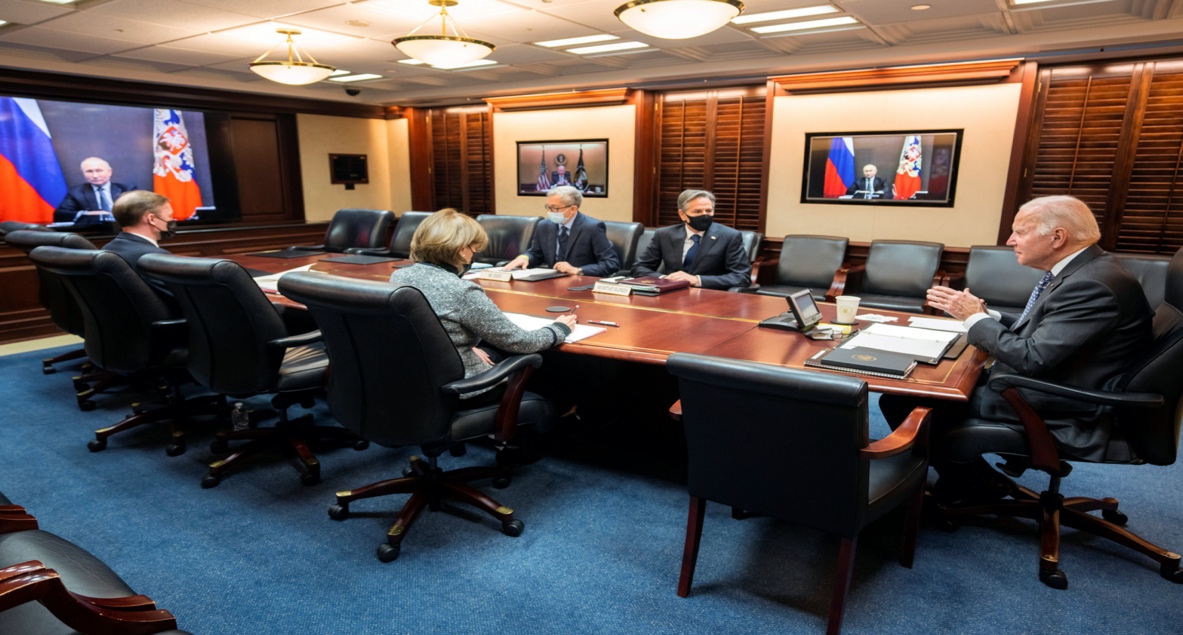Moscow to Washington: “Remove the Nukes on Our Doorstep and Stop the Eastward Push”
Mike Whitney
(Part One of special dossier)
SEE ALSO BY SAME AUTHOR: UNDERSTANDING UKRAINE IN 15 MINUTES
Dateline: JANUARY 25, 2022
Starting with the present article on Jan. 25, Mike Whitney has written three splendid essays illuminating what is in essence a protracted conflict between Russia and the US, a clash long in the making by America's continued denial of Russia's legitimate security interests, a devious and bellicose policy of strategic brinkmanship, and the stubborn pursuit of her destruction as a world power with a legitimate role in global affairs.—The Editor
Here’s a simple way to test your understanding of the current US-Russia standoff. All you need to do is answer one very-basic question about the nature of the conflict, and that answer will determine whether you understand what is actually going on or not. Here’s the question:
What is the source of the confrontation between the US and Russia in the Ukraine:
-
Russia has amassed over 100,000 combat troops near Ukraine’s eastern border and is threatening to invade.
-
Russian President Vladimir Putin wants to rebuild the Soviet Empire by expanding Russia’s territory beyond its borders.
-
The western media has concocted a fake storyline about a “Russian invasion” to divert attention from Moscow’s reasonable demands for legally-binding security guarantees that address the pressing issue of hostile foreign armies (NATO) and nuclear missiles on Russia’s doorstep.
-
None of the above.
Russia’s demands are both reasonable and appropriate. Russia isn’t asking for anything more than any sovereign country should expect. As FDR famously said, “Security for one, is security for all.” We support that sentiment and we think the American people do too.
Russians do not want to live with nuclear missiles aimed at their Capital and located just a few hundred miles from their targets. That is a nonstarter. Nor do Russians want hostile armies and military bases looming on their western flank in Ukraine. Again, that is a nonstarter. What Russia wants, is a written agreement that prevents Washington from using NATO to pursue its long-term geopolitical strategy of encircling, weakening and ultimately, splintering the Russian Federation into smaller pieces in order to become a bigger player in the development of Central Asia and in order to exert greater control over China’s explosive growth. That is the basic Gameplan, and the US foreign policy establishment has not abandoned that plan despite 30-years of catastrophic military failures stretching from North Africa across the Middle East and into Central Asia. Here’s how author Stephen Kinzer summed it up in an article that appeared in the Boston Globe more than a decade ago:
“From the moment the Soviet Union collapsed in 1991, the United States has relentlessly pursued a strategy of encircling Russia, just as it has with other perceived enemies like China and Iran. It has brought 12 countries in central Europe, all of them formerly allied with Moscow, into the NATO alliance. US military power is now directly on Russia’s borders…This crisis is in part the result of a zero-sum calculation that has shaped US policy toward Moscow since the Cold War: Any loss for Russia is an American victory, and anything positive that happens to, for, or in Russia is bad for the United States. This is an approach that intensifies confrontation, rather than soothing it.” (“US a full partner in Ukraine debacle”, Boston Globe)
What can we glean from this paragraph?
We can appreciate the historical context of the current crisis which dates back to the dissolution of the Soviet Union. Following the collapse of the USSR, leaders in the West felt that “History had ended” and that the western system had triumphed over communism. This triumphalism, in turn, was accompanied by wave after wave of eastward expansion, where NATO– the Cold War relic– doubled in size and pushed closer and closer to Russia’s borders. Now– 30-years on– Washington wants Ukraine to become a member of the Alliance which will put hostile armies, military bases and missile sites just a few hundred miles from Moscow. Naturally, Putin cannot allow this development to take place. Naturally, he must do everything in his power to prevent the supporters of this strategy from implementing their plan.
And that’s what the current confrontation is all about, Russia’s security. It has nothing to do with the threat of a Russian invasion. The “Russian invasion” meme was invented to garner public support for a confrontation with Russia and to conceal details about Russia’s security demands. It is basically fake news created with the clear intention of misleading the American people about an issue that should be a grave concern to them and to people around the world.
So, what is it that Putin wants, after all, we cannot determine whether the Russian leader is being reasonable or not unless we know what he is demanding. A short excerpt from the draft treaty should tell us everything we need to know. Here’s an excerpt:
The United States of America shall not establish military bases in the territory of the States of the former Union of Soviet Socialist Republics that are not members of the North Atlantic Treaty Organization, use their infrastructure for any military activities or develop bilateral military cooperation with them……
The Parties shall undertake not to deploy ground-launched intermediate-range and shorter-range missiles outside their national territories, as well as in the areas of their national territories, from which such weapons can attack targets in the national territory of the other Party.
The Parties shall refrain from deploying nuclear weapons outside their national territories and return such weapons already deployed outside their national territories at the time of the entry into force of the Treaty to their national territories. The Parties shall eliminate all existing infrastructure for deployment of nuclear weapons outside their national territories.
The Parties shall not train military and civilian personnel from non-nuclear countries to use nuclear weapons. The Parties shall not conduct exercises or training for general-purpose forces, that include scenarios involving the use of nuclear weapons.” (“Treaty between the United States and the Russian Federation on Security Guarantees,” Official Russian State Document, December 17, 2021)
Is it reasonable for Putin to demand that the US and its NATO allies not install military bases and nuclear missile sites on its border? Is it appropriate for the Russian president to insist that NATO abstain from placing hostile armies on Russia’s doorstep? Here’s what Putin said in reference to these developments just two weeks ago:
He has a point, doesn’t he? The US would never allow China or Russia to build bases or missile sites on its borders. Shouldn’t Russia expect the same treatment?
The head of the Russian delegation at the Vienna negotiations, Konstantin Gavrilov, summed it up like this:
Not necessarily, but the options are certainly narrowing. If the Biden administration ignores these red lines and continues to blunder ahead with its current policy, there will be a war because this latest NATO expansion leaves Russia at a critical disadvantage. The location of troops and nuclear weapons upsets the fundamental balance of power which Russia will be forced to restore by whatever means necessary. Is that what Biden’s foreign policy team wants?
The wiser members of the US foreign establishment have always cautioned against NATO’s reckless expansion. Check out this quote from former US diplomat and author of the Soviet “containment” policy, George Kennan, who warned that NATO expansion would have dire consequences for both Russia and the United States. He said:
So, if NATO expansion is at the heart of the present confrontation, (and not the invented threat of Putin invading.), then what are the strategic objectives?
Perhaps, the best and simplest explanation of what is going on is provided by foreign policy expert John Mearsheimer in a presentation he gave at The University of Chicago in 2015 titled Why is Ukraine the West’s Fault? The whole video is worth watching but for our purposes, we’ll highlight a few of the more crucial points.
First of all, US ambitions in Ukraine have nothing to do with “democracy promotion”. The real driving force is geopolitics, just as it was a century earlier when Great Britain was engaged in the Great Game. The same rule applies today, although the motives are more effectively concealed behind a wall of propaganda. As Mearsheimer says,
“The US and its EU allies want to peel Ukraine away from its Russian orbit and incorporate it into the west. The goal is to make Ukraine a western bulwark on Russia’s border.”
Bingo. That’s it in a nutshell. The US wants to continue its encirclement and weakening of Russia, and Russia will have none of it. As Mearsheimer says, “Russia is a great power and is has no interest in allowing the US to take a big piece of real estate of great strategic importance on its western border and incorporate it into the West.”
Right again. But while Mearsheimer provides a convincing explanation for recent developments, his analysis is in no way comprehensive. There are, of course, other prominent foreign policy experts who described in much greater detail, the role that was planned for Russia as a future colony in the New World Order. In 1997, Zbigniew Brzezinski posted an article in Foreign Policy Magazine titled “A Geostrategy for Eurasia,” that makes the case that the US needs to forcefully establish itself in Central Asia in order to maintain its position as the world’s only superpower. Here’s an excerpt that explains how Brzezinski saw Russia factoring in to this new paradigm:
“A loosely confederated Russia”? In other words, a splintered, Balkanized, bankrupt colony open to foreign exploitation and control. Is this Washington’s plan for Russia?
It is. A strong, vital and independent Russia is not in Washington’s interests at all, in fact, it is a clear threat to America’s global ambitions. The US still harbors lofty aspirations that have not been dampened by 30 years of foreign policy disasters. Washington still thinks it can prevail in its conflict with Moscow, establish outposts across Central Asia, further encircle China, and oversee the explosive development of the world’s most prosperous region, Asia. These are, perhaps, unrealistic objectives for a country that found it impossible to beat a makeshift militia with no formal military training (The Taliban) over a 20-year period. Nevertheless, this is the essential geopolitical roadmap the foreign policy establishment continues to pursue despite the fact that implementing the policy may trigger an unexpected conflagration with a nuclear-armed Russia that could have dire consequences for us all.
The views expressed herein are solely those of the author and may or may not reflect those of The Greanville Post. However, we do think they are important enough to be transmitted to a wider audience.
All image captions, pull quotes, appendices, etc. by the editors not the authors.
YOU ARE FREE TO REPRODUCE THIS ARTICLE PROVIDED YOU GIVE PROPER CREDIT TO THE GREANVILLE POST VIA A BACK LIVE LINK.
![]() This work is licensed under a Creative Commons Attribution-NonCommercial 4.0 International License
This work is licensed under a Creative Commons Attribution-NonCommercial 4.0 International License
[premium_newsticker id="211406"]
Don't forget to sign up for our FREE bulletin. Get The Greanville Post in your mailbox every few days.


